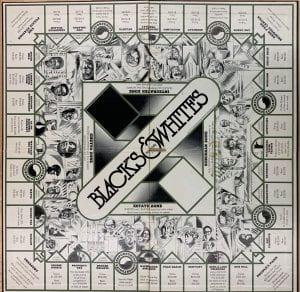Blacks & Whites is a board game published in 1970 by Judy Tart and Robert Sommer, a college psychology professor. It was made to educate white Americans on discrimination faced by black individuals in the United States. The game is like Monopoly: players take turns going around the board and can buy properties they land on. If one player lands on a house owned by another player, they pay rent to the owner. However, Blacks & Whites has a key difference from Monopoly: at the start of the game, each player chooses whether to play as a white or black player, and the rules of the game are different for each. The rules for black players are highly unfair at the start of the game. For example, black players start out with just $10,000 whereas white players start with $1,000,000. But as time goes on, the rules turn to strongly favor black players, making it easier for them to become as wealthy if not wealthier than white players. This inversion of stereotypes was purposefully designed to empower black Americans and make white Americans more conscious of the hardships often endured by the former. However, Blacks & Whites is more complicated than it seems.
Board games made for education during this time, like Blacks & Whites, have their origins in war games. After World War 2 ended in 1945, the U.S. military started to make “war games” to simulate real battles and prepare for future conflicts [1]. Then, researchers interested in worldwide politics started to make games to simulate possible policy crises [2]. This is how simulation games, called so because they aimed to simulate the real world as closely as possible, came to boom around the 1950s and 60s [3]. In the 60s and 70s, social science researchers in psychology and other fields joined the fray [4]. But rather than make games for their own research, these social scientists made games for students to play [5]. By making games that simulate the real world, they sought to educate students on important social issues. Blacks & Whites is one such educational simulation game. However, Blacks & Whites is different in that it was not made with the goal of simulating the real world as closely as possible.
Instead, Judy Tart and Robert Sommer made the game to imagine a world in which black individuals can rise above discrimination and prosper as much as white individuals. Many simulation games of this time period, because they model the real world so closely, often do not leave room for change. They reinforce the narratives of their time for better or worse. But by imagining a more equitable world, Tart and Sommer created a counternarrative: a game that aims to change the real world. They sought to do this by making people more aware of both racial injustices and ways to overcome them. Their game sought to promote equality for everyone regardless of skin color. But does it accomplish that goal?
Blacks & Whites is a game designed to show racial inequality more so than fight against it explicitly. Black players and white players play by their own rules throughout the game, demonstrating that neither group ever really escapes racial separation. This is even highlighted in the game’s title. What’s more, on the rule sheet the game explicitly encourages black players to work with other black players to succeed but doesn’t mention anything about collaboration with white players. Even the houses on the game board itself highlight this problem of separation. They’re organized, by price, into the “Ghetto Zone,” “Integrated Zone,” “Suburban Zone,” and “Estate Zone.” The rules say only white players can buy houses in the Suburban and Estate Zones. But, through a few situations, black players can become able to buy in these zones. If they do, however, the rules allow them to trigger a type of “white flight,” meaning that all the white property owners are forced out of that Zone. By doing so, Blacks & Whites imagines a world where economic racial barriers, but perhaps not social ones, are overcome.
Though Blacks & Whites might be problematic from this angle, it has value as a historical object. Like Monopoly, in Blacks & Whites if a player lands on certain tiles they collect an Opportunity Card. Most cards describe a historical event of the 1960s, making them valuable for both students and historians alike.
[1] Maidment, Robert and Russell H. Bronstein. Simulation Games. Charles E. Merrill Publishing Company, 1973, p.10
[2] Ibid.
[3] Boocock, Sarane Spence, and E. O. Schild. Simulation Games in Learning. Beverly Hills, Calif.: Sage Publications, 1968.
[4] Ibid p.11
[5] Ibid
Further reading
Association for Business Simulation and Experiential Learning, North American Simulation and Gaming Association, and International Simulation and Gaming Association. Simulation & Gaming. [Newbury Park, CA]: Sage Publications, 1990.
David W., Robert E. Horn, Paul A. Twelker, and Kent Layden. The Guide to Simulations/games for Education and Training. [2d ed.]. Lexington, Mass.: Information Resources, 1973.
Wagner, Guy. Educational Games and Activities. [Darien, Conn.: Teachers Pub. Corp., 1966.




